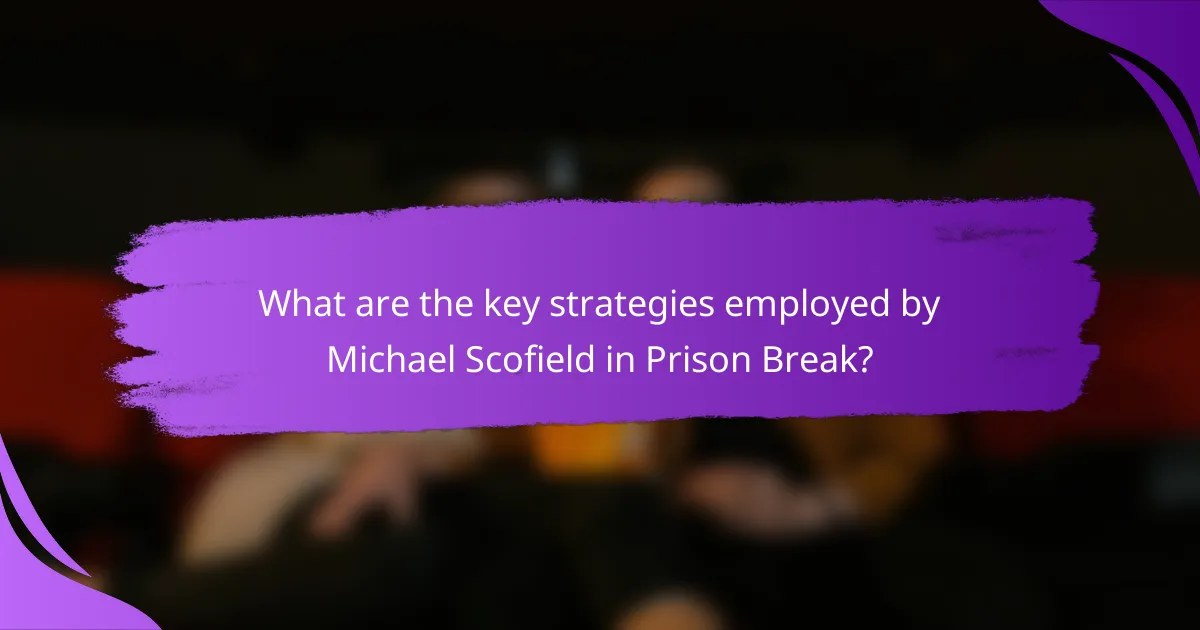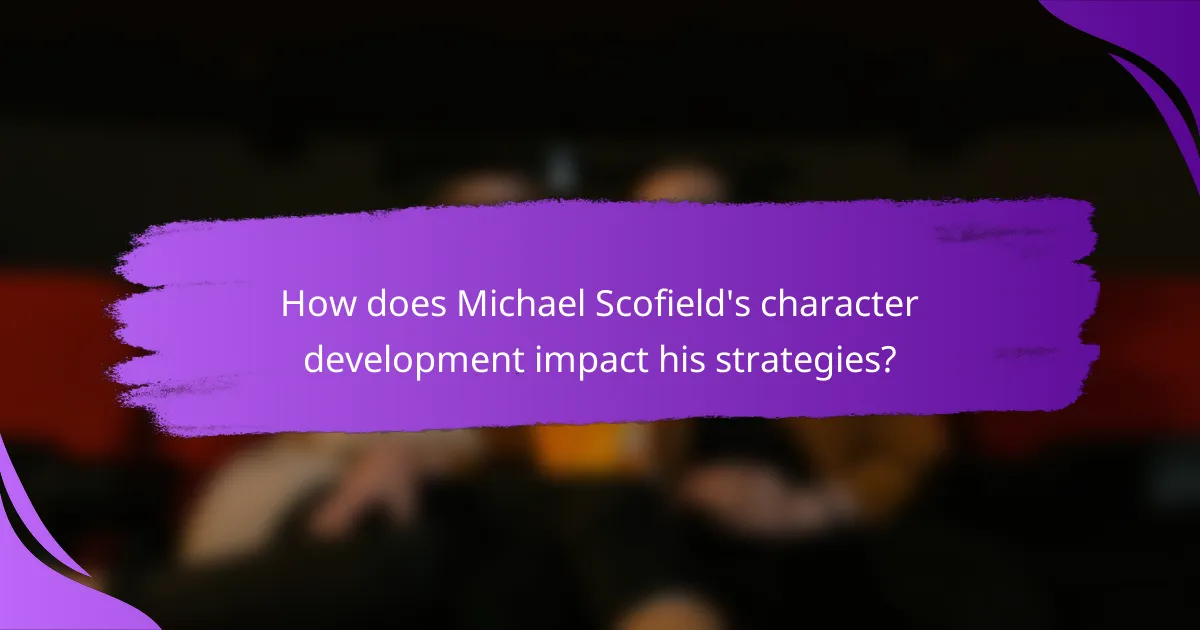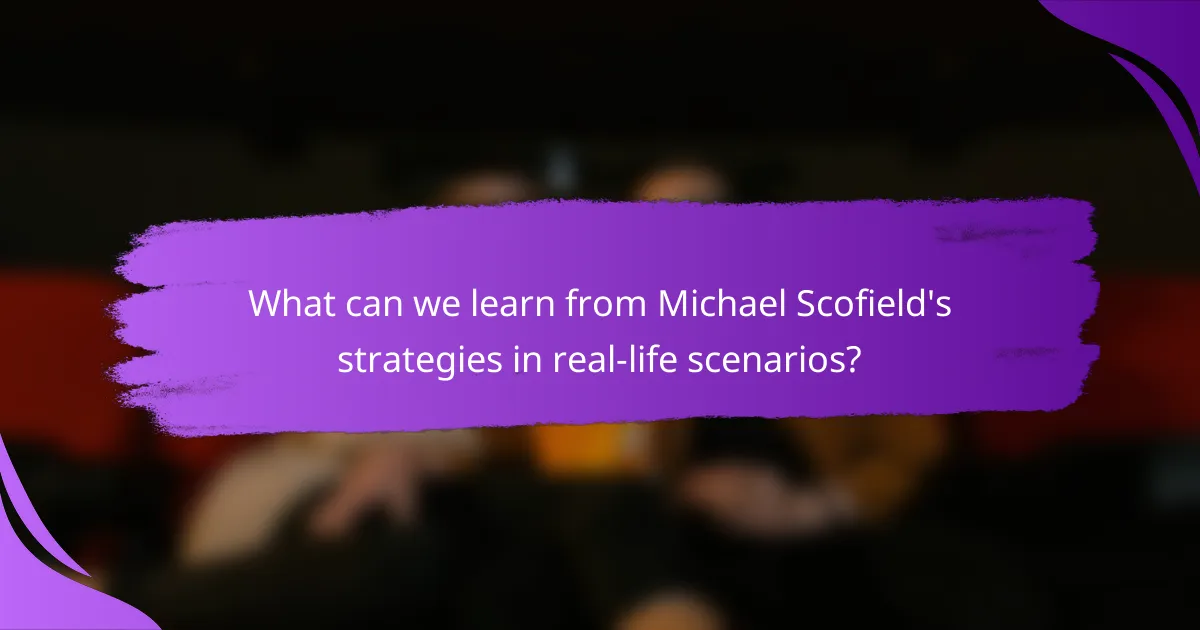Michael Scofield is the central figure in the series “Prison Break,” known for his strategic escape plans and engineering skills. The article delves into Scofield’s key strategies, including meticulous planning, alliance-building with fellow inmates, and the use of psychological tactics to manipulate situations. It highlights his character development, showcasing how his emotional and moral evolution enhances his strategic thinking. The discussion emphasizes the importance of thorough research, teamwork, and maintaining composure under pressure, illustrating how these strategies can be applied in real-life scenarios such as project management and crisis response. Overall, the article provides a comprehensive overview of Scofield’s tactical prowess and resourcefulness in overcoming complex challenges.

What are the key strategies employed by Michael Scofield in Prison Break?
Michael Scofield employs several key strategies in Prison Break. His primary strategy is meticulous planning. He designs a detailed escape plan based on the prison’s blueprints. Scofield uses his engineering skills to identify weaknesses in the prison’s security. He builds alliances with fellow inmates to gain support. Additionally, he creates diversions to distract guards during the escape. Scofield also manipulates circumstances to his advantage, using psychological tactics. He remains calm under pressure, adapting to unexpected challenges. Each strategy showcases his intelligence and resourcefulness throughout the series.
How does Michael Scofield utilize his engineering skills in his plans?
Michael Scofield utilizes his engineering skills to devise intricate escape plans. He applies structural knowledge to analyze prison layouts. Scofield designs blueprints that highlight weaknesses in security. He calculates precise timings for execution to avoid detection. His understanding of materials aids in creating tools for escape. Scofield often improvises based on real-time observations. He collaborates with inmates, sharing his technical expertise. These strategies demonstrate his engineering background as essential to his plans.
What specific engineering principles does he apply?
Michael Scofield applies principles of structural engineering and fluid dynamics. He utilizes structural engineering to analyze prison architecture and identify weaknesses. This includes understanding load-bearing walls and escape routes. Fluid dynamics principles help him devise methods for moving through confined spaces. He applies pressure and flow concepts to navigate ventilation systems. Scofield’s designs are informed by mechanical advantage and leverage. He often employs these principles to create tools or mechanisms for escape. His strategic planning is grounded in precise calculations and simulations. This analytical approach enhances the likelihood of successful execution of his plans.
How does his background in engineering influence his problem-solving abilities?
His background in engineering enhances his problem-solving abilities by providing a systematic approach to challenges. Engineers are trained to analyze problems logically and break them down into manageable parts. This skill allows him to identify root causes effectively. Additionally, engineering principles emphasize creativity in designing solutions. He uses this creativity to devise unconventional strategies. His education also fosters a deep understanding of technical systems, which aids in practical problem-solving. This combination of analytical thinking and creativity makes him a formidable strategist.
What mastermind tactics does Michael Scofield use to outsmart his opponents?
Michael Scofield employs several mastermind tactics to outsmart his opponents. He uses meticulous planning to anticipate their moves. Scofield often creates detailed blueprints of locations, allowing him to navigate complex environments. He leverages psychological manipulation to influence others’ decisions. Scofield also utilizes deception, crafting elaborate schemes to mislead opponents. He employs strategic alliances, gaining the trust of key individuals to achieve his goals. Additionally, Scofield adapts quickly to changing circumstances, recalibrating his strategies as needed. His engineering skills enable him to devise innovative solutions to obstacles. These tactics collectively demonstrate his ability to outthink and outmaneuver adversaries effectively.
What psychological strategies does he employ during his escapes?
Michael Scofield employs several psychological strategies during his escapes. He utilizes manipulation to influence others’ actions and decisions. Scofield often creates detailed plans that account for the psychological profiles of those around him. He builds trust with key individuals to gain their cooperation. Additionally, he employs misdirection to divert attention from his true intentions. This includes using complex narratives to mask his escape plans. Scofield also leverages fear and urgency to motivate others to act. By understanding human behavior, he effectively orchestrates situations to his advantage. These strategies demonstrate his mastery in psychological manipulation and tactical planning.
How does he manipulate situations to his advantage?
Michael Scofield manipulates situations to his advantage through strategic planning and psychological insight. He meticulously analyzes the environment and the people around him. Scofield often uses his engineering skills to create escape routes and solutions. He builds trust with key characters to gain their cooperation. By anticipating others’ moves, he stays one step ahead. He leverages his knowledge of prison systems to exploit weaknesses. This combination of intellect and manipulation allows him to control outcomes effectively. His actions demonstrate a clear understanding of human behavior, making him a master strategist.

How does Michael Scofield’s character development impact his strategies?
Michael Scofield’s character development significantly enhances his strategic thinking. Initially, he is portrayed as a meticulous planner. His engineering background allows him to devise complex escape plans. As the series progresses, he evolves emotionally and morally. This growth enables him to adapt his strategies to unforeseen challenges. He learns to trust others and delegate tasks. His relationships with fellow inmates influence his approach to problem-solving. Ultimately, his character depth enriches his tactical decisions, making them more effective and nuanced.
What personal motivations drive Scofield’s actions throughout the series?
Michael Scofield’s actions throughout the series are primarily driven by his desire to save his brother, Lincoln Burrows. This motivation stems from a deep sense of loyalty and familial bond. Scofield believes Lincoln is wrongfully imprisoned and faces a death sentence. To achieve his goal, he meticulously plans an elaborate escape. His engineering skills enable him to devise a detailed blueprint of the prison. Scofield also seeks to expose the corruption behind Lincoln’s conviction. His determination is fueled by the need to protect his family and restore justice. Throughout the series, these personal motivations shape his strategic decisions and actions.
How do his relationships influence his strategic decisions?
Michael Scofield’s relationships significantly influence his strategic decisions. His connections with other characters provide essential information and resources. For instance, his bond with Lincoln Burrows drives his motivation to devise escape plans. Additionally, Scofield’s rapport with fellow inmates allows him to gather intelligence on prison dynamics. Trust and loyalty in these relationships enable him to form alliances crucial for executing his strategies. His interactions with characters like Sara Tancredi highlight emotional stakes, impacting his choices. Overall, Scofield’s relationships serve as a foundation for his calculated and adaptive strategic approach.
What moral dilemmas does he face, and how do they affect his tactics?
Michael Scofield faces moral dilemmas related to loyalty, justice, and sacrifice. These dilemmas influence his tactics significantly. He struggles with the ethics of breaking the law to save his brother. This creates tension between his personal goals and the potential harm to others. His loyalty to family drives him to make risky decisions. He often weighs the consequences of his actions on innocent lives. This internal conflict shapes his strategic planning. He employs deception and manipulation to achieve his goals while grappling with guilt. Ultimately, his moral dilemmas lead him to prioritize outcomes over methods.
How does the setting of the prison influence Scofield’s strategies?
The prison setting significantly influences Scofield’s strategies. The physical layout of the prison dictates his escape plan’s feasibility. Scofield assesses security measures, guard routines, and surveillance systems within the prison. He utilizes the prison’s architecture to identify escape routes. The social dynamics among inmates also affect his approach. Scofield builds alliances to gather information and resources. The prison’s hierarchical structure influences his interactions with other characters. Each of these factors shapes the tactics he employs throughout the series.
What challenges does the prison environment present to his plans?
The prison environment presents significant challenges to Michael Scofield’s plans. Security measures in prisons are stringent, limiting movement and access. Surveillance systems monitor activities, making covert actions difficult. Inmates face isolation, which can hinder communication with allies. The presence of guards adds another layer of risk to any escape attempt. Additionally, prison layout is complex, with restricted areas that can trap individuals. Trust among inmates is often tenuous, complicating alliances. These factors collectively create a hostile environment for executing escape strategies.
How does he adapt his strategies to overcome these challenges?
Michael Scofield adapts his strategies by leveraging his engineering skills and analytical thinking. He assesses each challenge systematically to identify weaknesses in the prison system. Scofield uses detailed plans that account for contingencies, ensuring flexibility in his approach. He often collaborates with other inmates to gather intelligence and resources. This teamwork enhances his ability to execute complex escape plans. Additionally, Scofield modifies his tactics based on real-time observations and feedback. He remains calm under pressure, allowing him to pivot quickly when faced with unforeseen obstacles. This adaptability is crucial for navigating the unpredictable environment of prison.

What can we learn from Michael Scofield’s strategies in real-life scenarios?
Michael Scofield’s strategies emphasize careful planning and adaptability. He demonstrates the importance of thorough research before executing a plan. Scofield’s ability to anticipate obstacles showcases the value of foresight in problem-solving. His use of teamwork highlights the significance of collaboration in achieving complex goals. Additionally, he illustrates the necessity of maintaining composure under pressure. These strategies can be applied in various real-life scenarios, such as project management and crisis response. His character serves as a model for strategic thinking and resourcefulness in challenging situations.
What are the key takeaways from Scofield’s engineering approach to problem-solving?
Scofield’s engineering approach to problem-solving emphasizes systematic analysis and creative thinking. He identifies problems through thorough evaluation of constraints and resources. His method includes breaking down complex challenges into manageable components. Scofield often employs unconventional solutions that leverage his engineering background. He prioritizes adaptability in changing circumstances. Collaboration with others enhances his problem-solving effectiveness. His strategic planning involves anticipating potential obstacles. This approach demonstrates the importance of a structured yet flexible mindset in overcoming difficulties.
How can his methods be applied to complex situations outside of prison?
His methods can be applied to complex situations outside of prison by utilizing strategic planning and problem-solving skills. Michael Scofield’s approach emphasizes thorough analysis of the environment. This includes identifying key variables and potential obstacles. His methods also involve creating detailed plans that account for multiple scenarios. By anticipating challenges, he effectively mitigates risks. Collaboration with knowledgeable allies enhances the execution of complex strategies. Additionally, adaptability to changing circumstances is crucial in applying these methods. Real-world examples include crisis management and project planning. These applications demonstrate the effectiveness of Scofield’s tactics beyond prison settings.
What lessons can be drawn about strategic thinking from Scofield’s character?
Michael Scofield exemplifies strategic thinking through meticulous planning and adaptability. He demonstrates the importance of understanding the environment and anticipating potential obstacles. Scofield’s ability to analyze complex situations allows him to devise multiple contingency plans. His engineering background aids in creating innovative solutions to escape challenges. He also shows the value of collaboration, leveraging the strengths of others to achieve common goals. Furthermore, Scofield’s foresight in assessing risks highlights the need for calculated decision-making. These lessons illustrate that effective strategic thinking requires a blend of creativity, analysis, and teamwork.
How can individuals develop their own strategic skills inspired by Scofield?
Individuals can develop strategic skills inspired by Scofield by studying his problem-solving techniques. Analyzing his ability to think critically under pressure is essential. Practicing scenario planning can enhance foresight and adaptability. Engaging in puzzles or strategy games can improve logical reasoning. Collaborating with others on complex tasks fosters teamwork and diverse perspectives. Learning from real-life strategic thinkers can provide practical insights. Emulating Scofield’s meticulous planning can lead to better execution of ideas. These methods mirror the strategic approaches used by Scofield in “Prison Break.”
The main entity of the article is Michael Scofield, a character from the series “Prison Break,” known for his strategic escape plans and engineering skills. The article examines Scofield’s key strategies, including meticulous planning, psychological manipulation, and the application of engineering principles to navigate prison dynamics. It also explores his character development, personal motivations, and the moral dilemmas he faces, along with the challenges presented by the prison environment. Additionally, the article highlights lessons on strategic thinking and problem-solving that can be applied in real-life scenarios, drawing inspiration from Scofield’s methods.